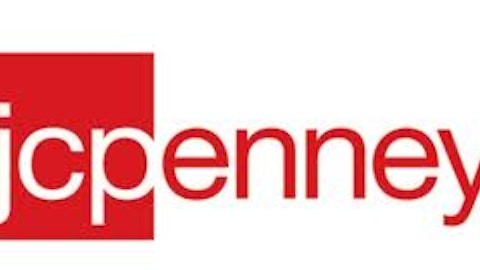Everywhere you look there seems to be retail chains with long histories and troubled finances. Once prosperous, these stores are attempting a turnaround in order to remain relevant in the age of the internet. As profits have fallen stock prices have followed, making investment in the stock a risky endeavor. But bond prices have also decreased, and by taking advantage of maturities only a few years away the rewards may outweigh the risks. Here are three troubled retailers which have attractive looking bonds.
J.C. Penney Company, Inc. (NYSE:JCP) – After years of slumping sales Penney began a multi-year turnaround under the leadership of new CEO Ron Johnson. The strategy involves breaking from the traditional model of handing out coupons and instead focusing on an ‘everyday low price’ model. Sales have continued to slump, with Q3 2012 seeing a year-on-year revenue decline of over 26%, although losses have narrowed.
The best looking Penney bond matures in 2017 and carries a 7.95% coupon (CUSIP: 708160BQ8). This bond is paid semi-annually and is non-callable, last trading below par at $95.50. The price has fallen considerably in the past year.
JCP Bond Price

Source: Finra
The yield to maturity, which factors in the return from both the coupon payments and the principal payment, is calculated below.


The yield to maturity of this bond is an impressive 10.84%, significantly higher than the current yield of 8.4% due to the below-par price. This bond matures in just over four years, which means that J.C. Penny’s financial situation needs to be strong enough to survive for at least that long. The balance sheet shows $525 million in cash and $2.94 billion in debt. The company paid $227 million in interest last year with a net income of $-152 million. Free cash flow was positive last year at $186 million but through three quarters of the current fiscal year has turned resoundingly negative, $-1.2 billion compared to $-600 million at the same time last year. This leads me to believe that free cash flow will be negative for the year.
Although J.C. Penny has enough cash to withstand a few years of losses, if the turnaround fails the company will very possibly go bankrupt before 2017. The default risk on this bond seems fairly high, but if you believe that the company can turn things around (like Morningstar does with its 5-star rating of the stock) then a YTM of 10.8% is highly attractive.
Sears Holdings Corporation (NASDAQ:SHLD)
The company merged with K-mart in 2005, soon after beginning a long stretch of declining revenue. Free cash flow turned negative in 2010 and has remained negative since. The turnaround was being led by CEO Louis D’Ambrosio, who announced in January that he would stepping down. This adds an extra element of uncertainty to the turnaround effort.
Sears’ bonds have been on the rise over the past year, but they still offer high yields. The 6.875% bond maturing in 2017 last traded at $91.51, up from around $70 one year ago (CUSIP: 812404AY7).
SHLD Bond Price

Source: Finra
This bond pays semi-annually and is continuously callable, irrelevant as long as the price is below par. The yield to maturity of this bond is calculated below.


This Sears bond has a yield to maturity of just over 10%, slightly below the JCP bond above. Sears and J.C. Penney are in similar financial states. Sears has $622 million in cash compared to $6.2 billion in debt and debt-like obligations, including pension liabilities. The company paid $289 in interest last year with a free cash flow of $-707 million.
I’d argue that Sears is in a worse condition than J.C. Penney, with more debt and less time for the turnaround strategy to stick. Again, if you believe the turnaround will be a success then the bond looks attractive. But I think J.C. Penney has a better chance than Sears.
RadioShack Corporation (NYSE:RSH)
I wrote about RadioShack in December, pointing out that the company was trading at less than its current assets minus total liabilities. This is what famed value investor Ben Graham called a Net-Net, and is usually an indication of an undervalued stock. Since the time of that writing the stock has risen from $2.38 to $3.27, a 37% increase in about two months. If only I had listened to my own advice.
Radio Shack has the highest-yielding bonds of the three companies. The bond maturing in 2019 with a 6.75% coupon last traded at $70.36, up from around $60 a few months ago (CUSIP: 750438AE3).
RSH Bond Price

Source: Finra
The yield to maturity calculation for this bond is shown below.


Although the RadioShack bond has a yield to maturity of over 15%, far higher than both J.C. Penney and Sears, I would argue that the company is in the best financial situation of the three. With $546 million in cash and $749 million in debt the company almost has enough cash to cover its debt. RadioShack’s balance sheet is the strongest of the three companies by far. The company paid $47 million in interest last year while their free cash flow turned negative in the middle of 2012. Still, as long as the losses don’t accelerate the cash position should sustain the company for far longer than J.C. Penney or Sears. Radio Shack has by far the lowest default risk even while offering the highest YTM.
Financial data from Morningstar
The article High-Yielding Troubled Retailer Bonds originally appeared on Fool.com and is written by Timothy Green.
Copyright © 1995 – 2013 The Motley Fool, LLC. All rights reserved. The Motley Fool has a disclosure policy.




